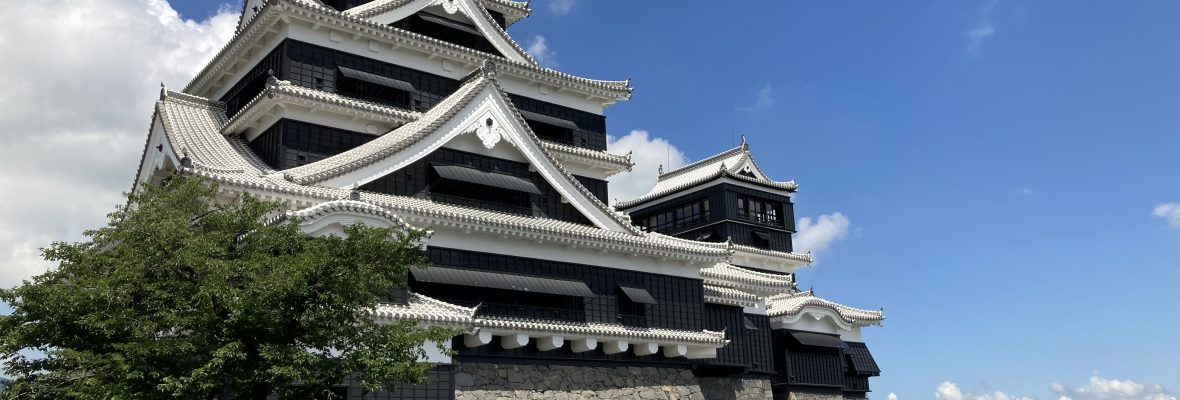The Iwami Silver mine (Shimane Prefecture) was discovered in 1526 and quickly developed in 1527. Legend has it, Kamiya Jyutei, a Hakata merchant spotted it from a boat on his way to the Sagi copper mine in Izumo (Shimane Prefecture). According to the Iwami Ginzan Youshu, Kamiya was sailing east on the Sea of Japan from the trade port of Hakata in northern Kyushu when he noticed a glittering mountain in the sunshine. He asked one of the deckhands what the name of the mountain was. The deckhand gave Kamiya two names. One was Ginbusen (silver mountain) and the other, Sennoyama (仙ノ山). Sennoyama is the same name used today. On his arrival at the copper mine, Kamiya consulted with the mine manager Mishima Seiemon about Sennoyama. Seiemon quickly sent three engineers, Yoshida Mitsuemon, Yoshida Tozaemon, and Obeni Magoemon on an exploratory mission which proved successful.
The Kamiya were a powerful merchant family from Hakata. According to Kamiya clan history, the founding father was Nagatomi, second in line was Kazue and third in line was Jyutei. In 1538 Kazue personally served as chief sailor/trader on a trade mission to Ming China authorized by Lord Ouchi Yoshitaka. This indicates that the Ouchi clan were using wealthy merchants from Hakata to trade silver and copper with Ming China. Jyutei, by chance, noticed the glittering silver ores on Sennoyama on a business trip to buy copper from the Izumo mines for a trade mission to China.
Ouchi Yoshitaka was the regional lord governing the region containing the mines at that time. The Ouchi received significant profits with their monopolized trade of copper and silver with the Ming with was known as Kango Boeki which required special licenses between trading parties, which was completely monopolised with merchants in Hakata. The Kamiya clan were a member of this powerful Kango Boeki group and actively promoted copper and silver trade between the Ouchi, Ming China and Joseon Korea.
We have two interesting records in the Annals of the Joseon Dynasty.
On January the 10th, 1528, Bag Gyeson and his associates were arrested for secretly refining lead ores containing silver at Hwang Yunbich’s house in Seoul. On August the 2nd, 1539, Yu Seojong, a local official in Jeonju, Jeola Province, was arrested because he had secretly bought lead ores containing silver which came from Japan. People were secretly refined the ore at home and taught the skill to some Japanese people. These accounts suggest that by 1539 the Koreans had found an efficient way of extracting the silver and passed on the refining method to Japanese associates or traders.
During the early days of the Iwami mine, silver ore was shipped to the Korean Peninsula via Hakata for smelting. However, this method proved expensive as only high quality ore was acceptable for smelting and much of it was wasted. Kamiya Jyutei tracked down two Korean men, Keiyu and Soutan, living in Hakata who knew a new method of refining the silver. These two men introduced the haifuki (cupellation method) in 1533 which significantly improved the quality and output of silver from the mine.
Although the dates do not quite match up, these two records show that there was an exchange between the Koreans and their methods of extracting the silver and how the Japanese merchants gained the knowledge to extract the silver in a more efficient manner.
So, once cupellation was introduced into Japan, the method quickly spread to other silver mines in the country. As early as in August of 1542, silver ores were first dug on the south slope of Mt. Shiro-yama in Ikuno, Tajima Province, which later became one of the most well-known silver mines in Japan. Mine workers and engineers arrived at Ikuno, sent from the Iwami Silver Mine with all the technology and know-how to extract the silver and with it, considerable profits.
At the time, merchants in Hakata managed the silver mines, daimyos and local samurai put taxes on the management. Thus, silver taxes were, in one sense, shared between merchants and the ruling samurai. However, during the 1530s and 40s, silver was not yet used as domestic currency, it was still only used in exchange for foreign products.
In just five years, records of Japanese silver began appearing in Korean and Chinese documents. The demand for Japanese silver significantly increased in a short period of time. By the end of the 15th century Ming China had transitioned into a ‘silver economy’ and as the economy grew so did the demand for silver. Korean aristocrats were big importers of fine Chinese goods and Japanese silver was their main trading currency as well. Iwami silver flooded the mainland. Just how much silver? Well, according to the Annals of Joseon in 1542 a priest named Ansin, was sent to Korea by an unknown daimyo with 80,000 ryo or about 3.2 tons of silver, in order to force a new trade deal. There are also accounts of Chinese merchants bound for Japanese with dreams of securing silver trade rights, only to be dismissed and begin a life of piracy.
Stu
References.
三宅亨, 倭寇と王直, 日本と東アジアのコミュニケーションの総合的研究
戦国大名の海外交易 (名古屋学院大学総合研究所研究叢書 31) 2019 by 鹿毛敏夫 (The Overseas Trade of the Sengoku Daimyos (Nagoya Gakuin University Research Institute Research Series 31) )2019 by Toshio Kage.
Hazard. B, The Formative Years of The Wakō, 1223-63, Monumenta Nipponica , 1967, Vol. 22, No. 3/4 (1967), pp. 260-277, Sophia University
Oka Mihoko, Ed, 2022, War and Trade in Maritime East Asia, Palgrave MacMillan
Zuikei Shuho and Charlotte von Verschuer, Japan’s Foreign Relations 1200 to 1392 A.D.: A Translation from “Zenrin Kokuhōki”, Monumenta Nipponica , Winter, 2002, Vol. 57, No. 4 (Winter, 2002), pp. 413-445, Sofia University.


Great article, much enjoyed.
LikeLiked by 1 person
Thanks mate. Stay tuned for parts 3 and 4.
LikeLiked by 1 person